Comparative Analysis of Motivation Theories: Herzberg, Maslow, etc.
VerifiedAdded on 2020/03/28
|7
|1603
|216
Discussion Board Post
AI Summary
This discussion board post examines several key theories of motivation. It begins with an overview of Herzberg's Motivator-Hygiene Theory, which differentiates factors leading to job satisfaction and dissatisfaction. The post then explores the application of this theory, including the steps to eliminate dissatisfaction and create conditions for satisfaction. Next, it discusses Maslow's Hierarchy of Needs, emphasizing the ranking of needs from physiological to self-actualization. The post concludes with a discussion of empowerment, defining it as the creation of self-determination within individuals or groups, and it touches upon how organizational culture can be used to empower employees, including methods to attract, develop, and empower employees. References are provided for each theory discussed.

Name of student:
Registration number:
Unit Code:
Unit Title:
Name of supervisor:
Date due:
Registration number:
Unit Code:
Unit Title:
Name of supervisor:
Date due:
Paraphrase This Document
Need a fresh take? Get an instant paraphrase of this document with our AI Paraphraser
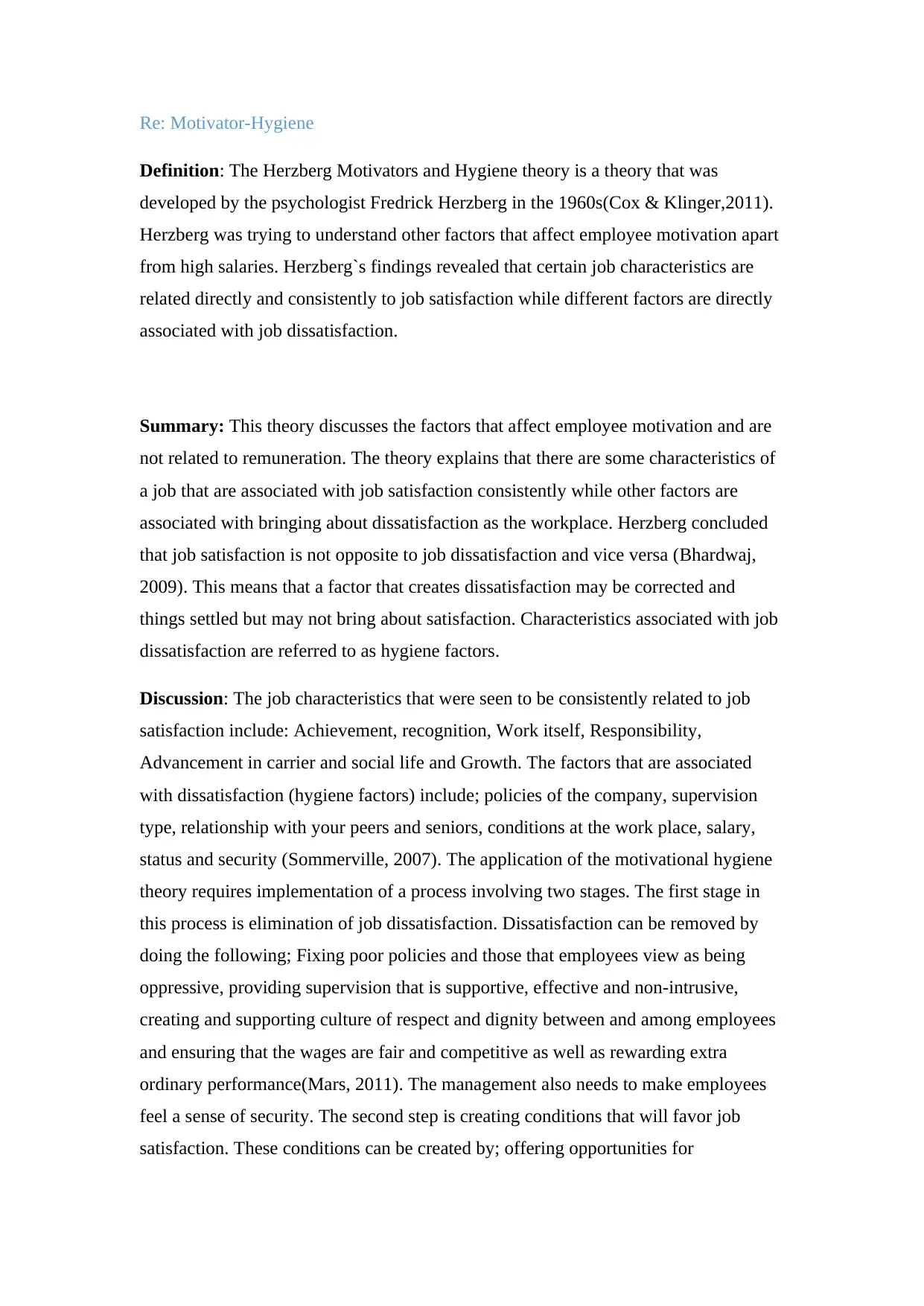
Re: Motivator-Hygiene
Definition: The Herzberg Motivators and Hygiene theory is a theory that was
developed by the psychologist Fredrick Herzberg in the 1960s(Cox & Klinger,2011).
Herzberg was trying to understand other factors that affect employee motivation apart
from high salaries. Herzberg`s findings revealed that certain job characteristics are
related directly and consistently to job satisfaction while different factors are directly
associated with job dissatisfaction.
Summary: This theory discusses the factors that affect employee motivation and are
not related to remuneration. The theory explains that there are some characteristics of
a job that are associated with job satisfaction consistently while other factors are
associated with bringing about dissatisfaction as the workplace. Herzberg concluded
that job satisfaction is not opposite to job dissatisfaction and vice versa (Bhardwaj,
2009). This means that a factor that creates dissatisfaction may be corrected and
things settled but may not bring about satisfaction. Characteristics associated with job
dissatisfaction are referred to as hygiene factors.
Discussion: The job characteristics that were seen to be consistently related to job
satisfaction include: Achievement, recognition, Work itself, Responsibility,
Advancement in carrier and social life and Growth. The factors that are associated
with dissatisfaction (hygiene factors) include; policies of the company, supervision
type, relationship with your peers and seniors, conditions at the work place, salary,
status and security (Sommerville, 2007). The application of the motivational hygiene
theory requires implementation of a process involving two stages. The first stage in
this process is elimination of job dissatisfaction. Dissatisfaction can be removed by
doing the following; Fixing poor policies and those that employees view as being
oppressive, providing supervision that is supportive, effective and non-intrusive,
creating and supporting culture of respect and dignity between and among employees
and ensuring that the wages are fair and competitive as well as rewarding extra
ordinary performance(Mars, 2011). The management also needs to make employees
feel a sense of security. The second step is creating conditions that will favor job
satisfaction. These conditions can be created by; offering opportunities for
Definition: The Herzberg Motivators and Hygiene theory is a theory that was
developed by the psychologist Fredrick Herzberg in the 1960s(Cox & Klinger,2011).
Herzberg was trying to understand other factors that affect employee motivation apart
from high salaries. Herzberg`s findings revealed that certain job characteristics are
related directly and consistently to job satisfaction while different factors are directly
associated with job dissatisfaction.
Summary: This theory discusses the factors that affect employee motivation and are
not related to remuneration. The theory explains that there are some characteristics of
a job that are associated with job satisfaction consistently while other factors are
associated with bringing about dissatisfaction as the workplace. Herzberg concluded
that job satisfaction is not opposite to job dissatisfaction and vice versa (Bhardwaj,
2009). This means that a factor that creates dissatisfaction may be corrected and
things settled but may not bring about satisfaction. Characteristics associated with job
dissatisfaction are referred to as hygiene factors.
Discussion: The job characteristics that were seen to be consistently related to job
satisfaction include: Achievement, recognition, Work itself, Responsibility,
Advancement in carrier and social life and Growth. The factors that are associated
with dissatisfaction (hygiene factors) include; policies of the company, supervision
type, relationship with your peers and seniors, conditions at the work place, salary,
status and security (Sommerville, 2007). The application of the motivational hygiene
theory requires implementation of a process involving two stages. The first stage in
this process is elimination of job dissatisfaction. Dissatisfaction can be removed by
doing the following; Fixing poor policies and those that employees view as being
oppressive, providing supervision that is supportive, effective and non-intrusive,
creating and supporting culture of respect and dignity between and among employees
and ensuring that the wages are fair and competitive as well as rewarding extra
ordinary performance(Mars, 2011). The management also needs to make employees
feel a sense of security. The second step is creating conditions that will favor job
satisfaction. These conditions can be created by; offering opportunities for
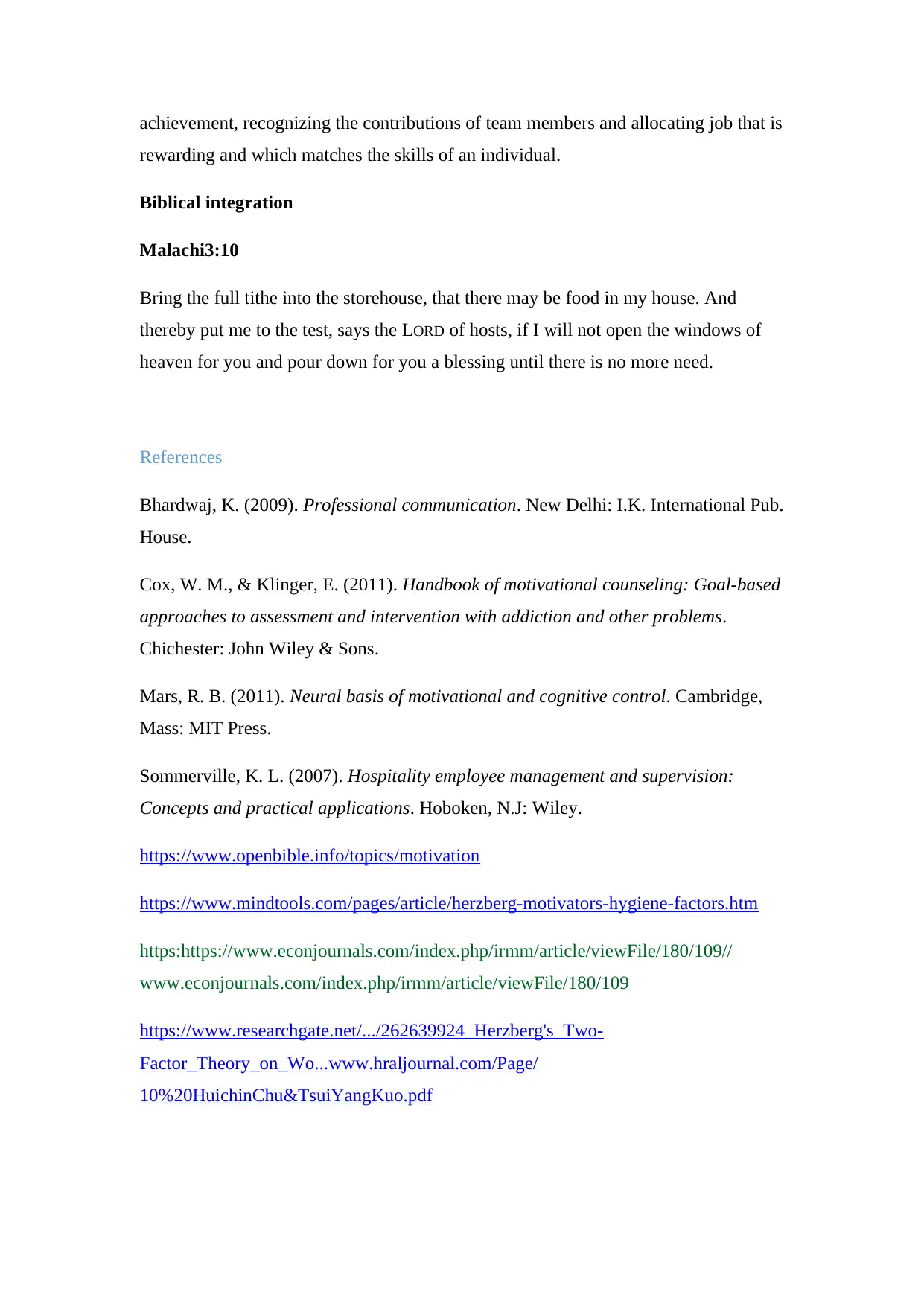
achievement, recognizing the contributions of team members and allocating job that is
rewarding and which matches the skills of an individual.
Biblical integration
Malachi3:10
Bring the full tithe into the storehouse, that there may be food in my house. And
thereby put me to the test, says the LORD of hosts, if I will not open the windows of
heaven for you and pour down for you a blessing until there is no more need.
References
Bhardwaj, K. (2009). Professional communication. New Delhi: I.K. International Pub.
House.
Cox, W. M., & Klinger, E. (2011). Handbook of motivational counseling: Goal-based
approaches to assessment and intervention with addiction and other problems.
Chichester: John Wiley & Sons.
Mars, R. B. (2011). Neural basis of motivational and cognitive control. Cambridge,
Mass: MIT Press.
Sommerville, K. L. (2007). Hospitality employee management and supervision:
Concepts and practical applications. Hoboken, N.J: Wiley.
https://www.openbible.info/topics/motivation
https://www.mindtools.com/pages/article/herzberg-motivators-hygiene-factors.htm
https:https://www.econjournals.com/index.php/irmm/article/viewFile/180/109//
www.econjournals.com/index.php/irmm/article/viewFile/180/109
https://www.researchgate.net/.../262639924_Herzberg's_Two-
Factor_Theory_on_Wo...www.hraljournal.com/Page/
10%20HuichinChu&TsuiYangKuo.pdf
rewarding and which matches the skills of an individual.
Biblical integration
Malachi3:10
Bring the full tithe into the storehouse, that there may be food in my house. And
thereby put me to the test, says the LORD of hosts, if I will not open the windows of
heaven for you and pour down for you a blessing until there is no more need.
References
Bhardwaj, K. (2009). Professional communication. New Delhi: I.K. International Pub.
House.
Cox, W. M., & Klinger, E. (2011). Handbook of motivational counseling: Goal-based
approaches to assessment and intervention with addiction and other problems.
Chichester: John Wiley & Sons.
Mars, R. B. (2011). Neural basis of motivational and cognitive control. Cambridge,
Mass: MIT Press.
Sommerville, K. L. (2007). Hospitality employee management and supervision:
Concepts and practical applications. Hoboken, N.J: Wiley.
https://www.openbible.info/topics/motivation
https://www.mindtools.com/pages/article/herzberg-motivators-hygiene-factors.htm
https:https://www.econjournals.com/index.php/irmm/article/viewFile/180/109//
www.econjournals.com/index.php/irmm/article/viewFile/180/109
https://www.researchgate.net/.../262639924_Herzberg's_Two-
Factor_Theory_on_Wo...www.hraljournal.com/Page/
10%20HuichinChu&TsuiYangKuo.pdf
⊘ This is a preview!⊘
Do you want full access?
Subscribe today to unlock all pages.

Trusted by 1+ million students worldwide
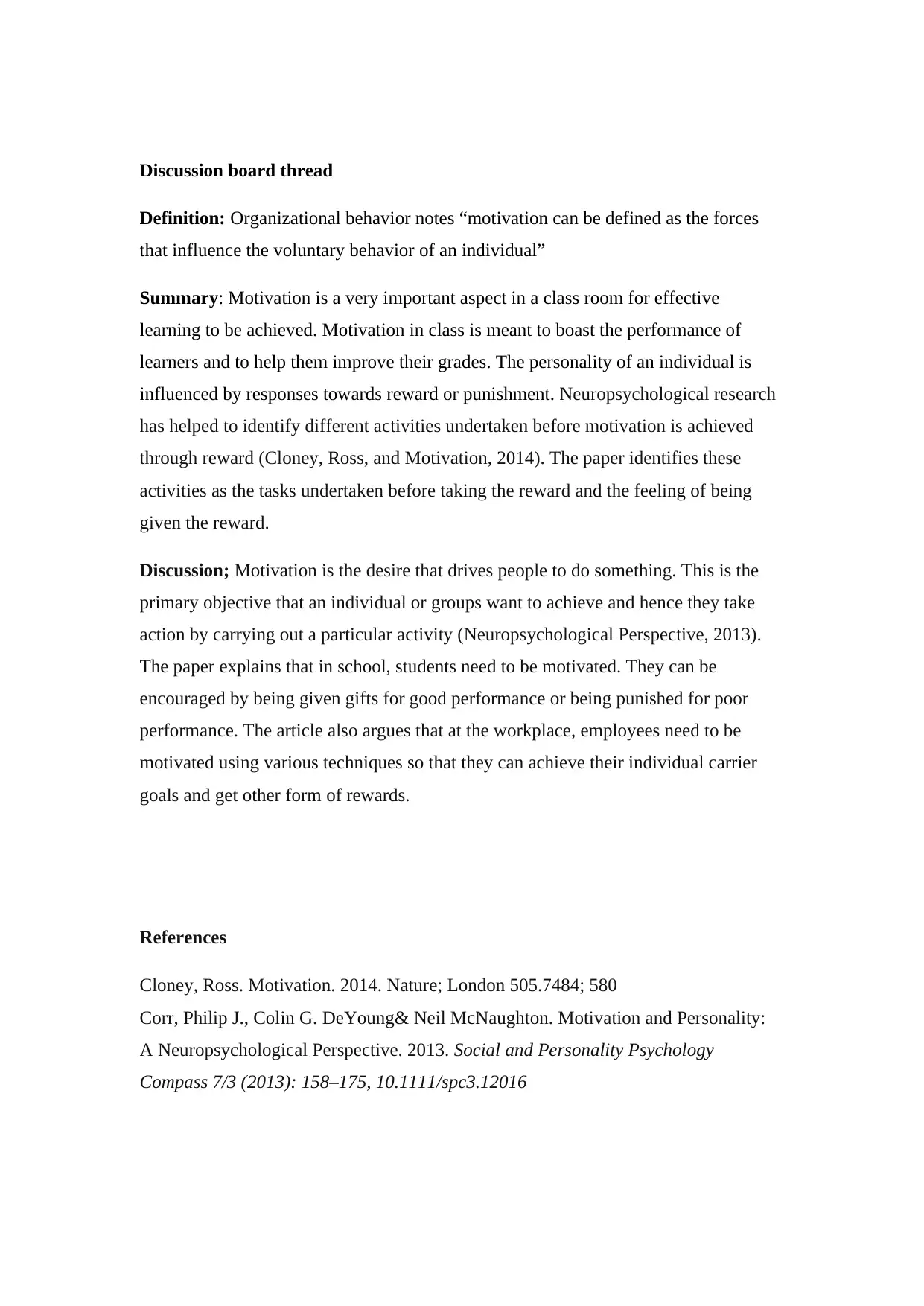
Discussion board thread
Definition: Organizational behavior notes “motivation can be defined as the forces
that influence the voluntary behavior of an individual”
Summary: Motivation is a very important aspect in a class room for effective
learning to be achieved. Motivation in class is meant to boast the performance of
learners and to help them improve their grades. The personality of an individual is
influenced by responses towards reward or punishment. Neuropsychological research
has helped to identify different activities undertaken before motivation is achieved
through reward (Cloney, Ross, and Motivation, 2014). The paper identifies these
activities as the tasks undertaken before taking the reward and the feeling of being
given the reward.
Discussion; Motivation is the desire that drives people to do something. This is the
primary objective that an individual or groups want to achieve and hence they take
action by carrying out a particular activity (Neuropsychological Perspective, 2013).
The paper explains that in school, students need to be motivated. They can be
encouraged by being given gifts for good performance or being punished for poor
performance. The article also argues that at the workplace, employees need to be
motivated using various techniques so that they can achieve their individual carrier
goals and get other form of rewards.
References
Cloney, Ross. Motivation. 2014. Nature; London 505.7484; 580
Corr, Philip J., Colin G. DeYoung& Neil McNaughton. Motivation and Personality:
A Neuropsychological Perspective. 2013. Social and Personality Psychology
Compass 7/3 (2013): 158–175, 10.1111/spc3.12016
Definition: Organizational behavior notes “motivation can be defined as the forces
that influence the voluntary behavior of an individual”
Summary: Motivation is a very important aspect in a class room for effective
learning to be achieved. Motivation in class is meant to boast the performance of
learners and to help them improve their grades. The personality of an individual is
influenced by responses towards reward or punishment. Neuropsychological research
has helped to identify different activities undertaken before motivation is achieved
through reward (Cloney, Ross, and Motivation, 2014). The paper identifies these
activities as the tasks undertaken before taking the reward and the feeling of being
given the reward.
Discussion; Motivation is the desire that drives people to do something. This is the
primary objective that an individual or groups want to achieve and hence they take
action by carrying out a particular activity (Neuropsychological Perspective, 2013).
The paper explains that in school, students need to be motivated. They can be
encouraged by being given gifts for good performance or being punished for poor
performance. The article also argues that at the workplace, employees need to be
motivated using various techniques so that they can achieve their individual carrier
goals and get other form of rewards.
References
Cloney, Ross. Motivation. 2014. Nature; London 505.7484; 580
Corr, Philip J., Colin G. DeYoung& Neil McNaughton. Motivation and Personality:
A Neuropsychological Perspective. 2013. Social and Personality Psychology
Compass 7/3 (2013): 158–175, 10.1111/spc3.12016
Paraphrase This Document
Need a fresh take? Get an instant paraphrase of this document with our AI Paraphraser
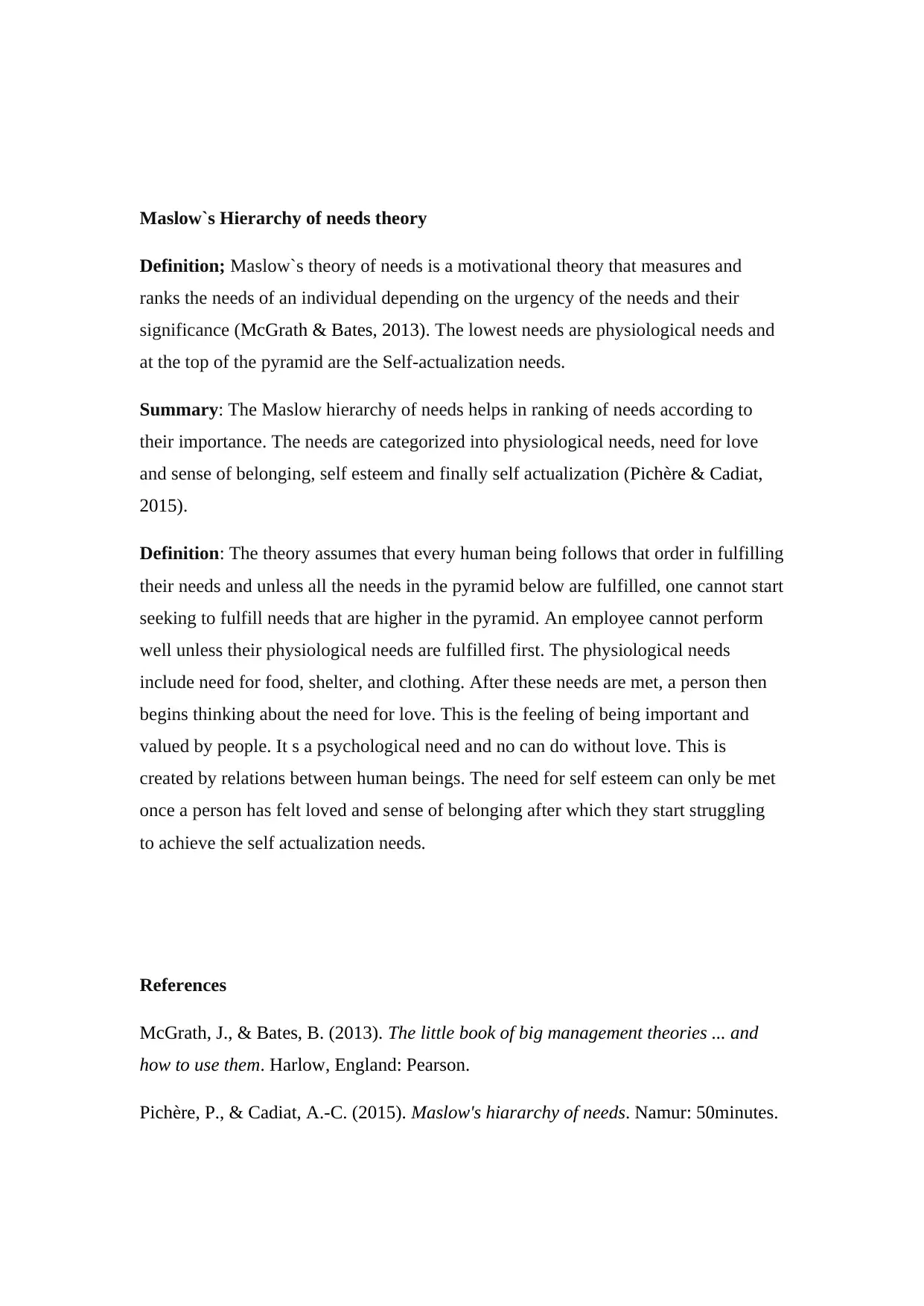
Maslow`s Hierarchy of needs theory
Definition; Maslow`s theory of needs is a motivational theory that measures and
ranks the needs of an individual depending on the urgency of the needs and their
significance (McGrath & Bates, 2013). The lowest needs are physiological needs and
at the top of the pyramid are the Self-actualization needs.
Summary: The Maslow hierarchy of needs helps in ranking of needs according to
their importance. The needs are categorized into physiological needs, need for love
and sense of belonging, self esteem and finally self actualization (Pichère & Cadiat,
2015).
Definition: The theory assumes that every human being follows that order in fulfilling
their needs and unless all the needs in the pyramid below are fulfilled, one cannot start
seeking to fulfill needs that are higher in the pyramid. An employee cannot perform
well unless their physiological needs are fulfilled first. The physiological needs
include need for food, shelter, and clothing. After these needs are met, a person then
begins thinking about the need for love. This is the feeling of being important and
valued by people. It s a psychological need and no can do without love. This is
created by relations between human beings. The need for self esteem can only be met
once a person has felt loved and sense of belonging after which they start struggling
to achieve the self actualization needs.
References
McGrath, J., & Bates, B. (2013). The little book of big management theories ... and
how to use them. Harlow, England: Pearson.
Pichère, P., & Cadiat, A.-C. (2015). Maslow's hiararchy of needs. Namur: 50minutes.
Definition; Maslow`s theory of needs is a motivational theory that measures and
ranks the needs of an individual depending on the urgency of the needs and their
significance (McGrath & Bates, 2013). The lowest needs are physiological needs and
at the top of the pyramid are the Self-actualization needs.
Summary: The Maslow hierarchy of needs helps in ranking of needs according to
their importance. The needs are categorized into physiological needs, need for love
and sense of belonging, self esteem and finally self actualization (Pichère & Cadiat,
2015).
Definition: The theory assumes that every human being follows that order in fulfilling
their needs and unless all the needs in the pyramid below are fulfilled, one cannot start
seeking to fulfill needs that are higher in the pyramid. An employee cannot perform
well unless their physiological needs are fulfilled first. The physiological needs
include need for food, shelter, and clothing. After these needs are met, a person then
begins thinking about the need for love. This is the feeling of being important and
valued by people. It s a psychological need and no can do without love. This is
created by relations between human beings. The need for self esteem can only be met
once a person has felt loved and sense of belonging after which they start struggling
to achieve the self actualization needs.
References
McGrath, J., & Bates, B. (2013). The little book of big management theories ... and
how to use them. Harlow, England: Pearson.
Pichère, P., & Cadiat, A.-C. (2015). Maslow's hiararchy of needs. Namur: 50minutes.
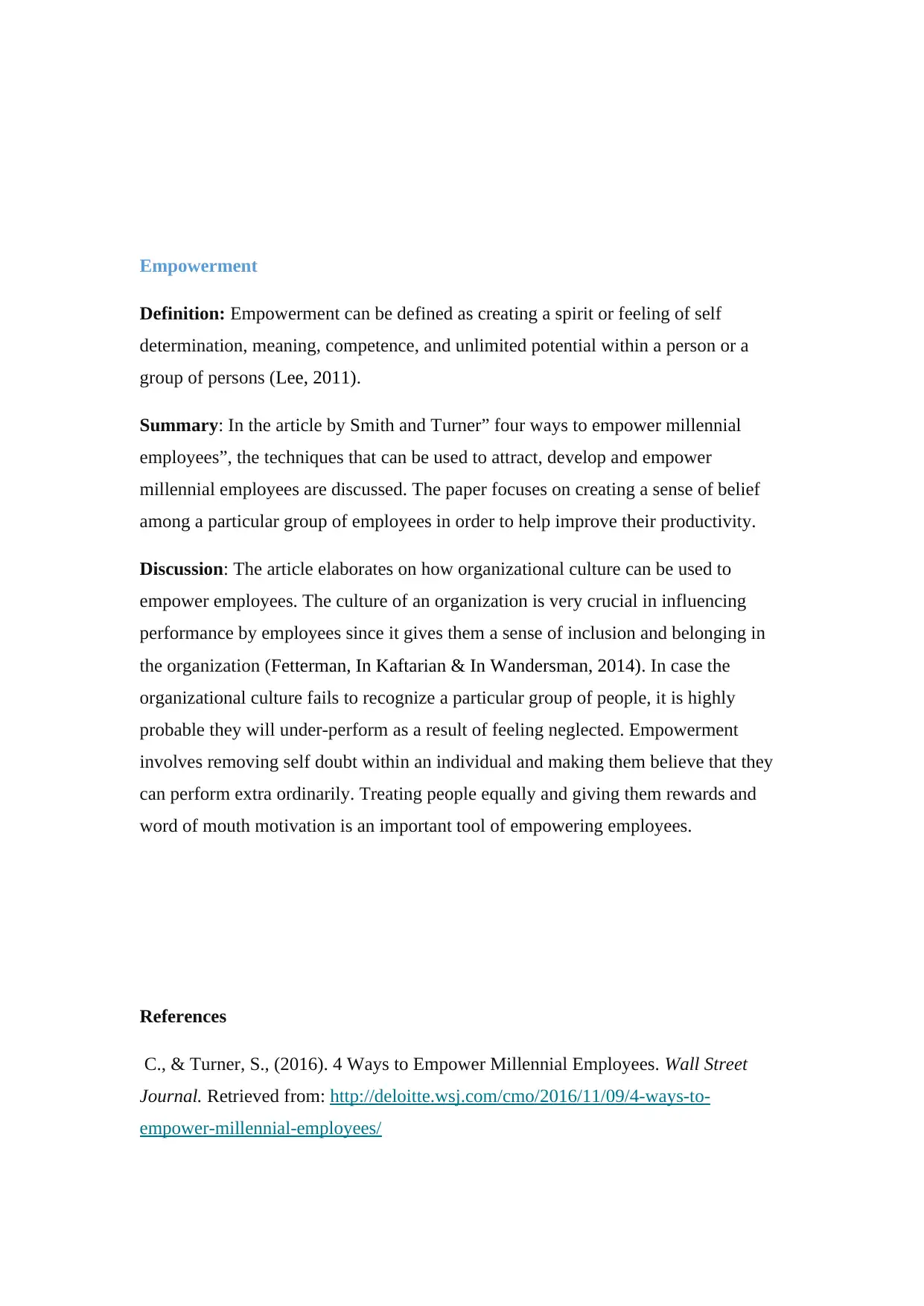
Empowerment
Definition: Empowerment can be defined as creating a spirit or feeling of self
determination, meaning, competence, and unlimited potential within a person or a
group of persons (Lee, 2011).
Summary: In the article by Smith and Turner” four ways to empower millennial
employees”, the techniques that can be used to attract, develop and empower
millennial employees are discussed. The paper focuses on creating a sense of belief
among a particular group of employees in order to help improve their productivity.
Discussion: The article elaborates on how organizational culture can be used to
empower employees. The culture of an organization is very crucial in influencing
performance by employees since it gives them a sense of inclusion and belonging in
the organization (Fetterman, In Kaftarian & In Wandersman, 2014). In case the
organizational culture fails to recognize a particular group of people, it is highly
probable they will under-perform as a result of feeling neglected. Empowerment
involves removing self doubt within an individual and making them believe that they
can perform extra ordinarily. Treating people equally and giving them rewards and
word of mouth motivation is an important tool of empowering employees.
References
C., & Turner, S., (2016). 4 Ways to Empower Millennial Employees. Wall Street
Journal. Retrieved from: http://deloitte.wsj.com/cmo/2016/11/09/4-ways-to-
empower-millennial-employees/
Definition: Empowerment can be defined as creating a spirit or feeling of self
determination, meaning, competence, and unlimited potential within a person or a
group of persons (Lee, 2011).
Summary: In the article by Smith and Turner” four ways to empower millennial
employees”, the techniques that can be used to attract, develop and empower
millennial employees are discussed. The paper focuses on creating a sense of belief
among a particular group of employees in order to help improve their productivity.
Discussion: The article elaborates on how organizational culture can be used to
empower employees. The culture of an organization is very crucial in influencing
performance by employees since it gives them a sense of inclusion and belonging in
the organization (Fetterman, In Kaftarian & In Wandersman, 2014). In case the
organizational culture fails to recognize a particular group of people, it is highly
probable they will under-perform as a result of feeling neglected. Empowerment
involves removing self doubt within an individual and making them believe that they
can perform extra ordinarily. Treating people equally and giving them rewards and
word of mouth motivation is an important tool of empowering employees.
References
C., & Turner, S., (2016). 4 Ways to Empower Millennial Employees. Wall Street
Journal. Retrieved from: http://deloitte.wsj.com/cmo/2016/11/09/4-ways-to-
empower-millennial-employees/
⊘ This is a preview!⊘
Do you want full access?
Subscribe today to unlock all pages.

Trusted by 1+ million students worldwide
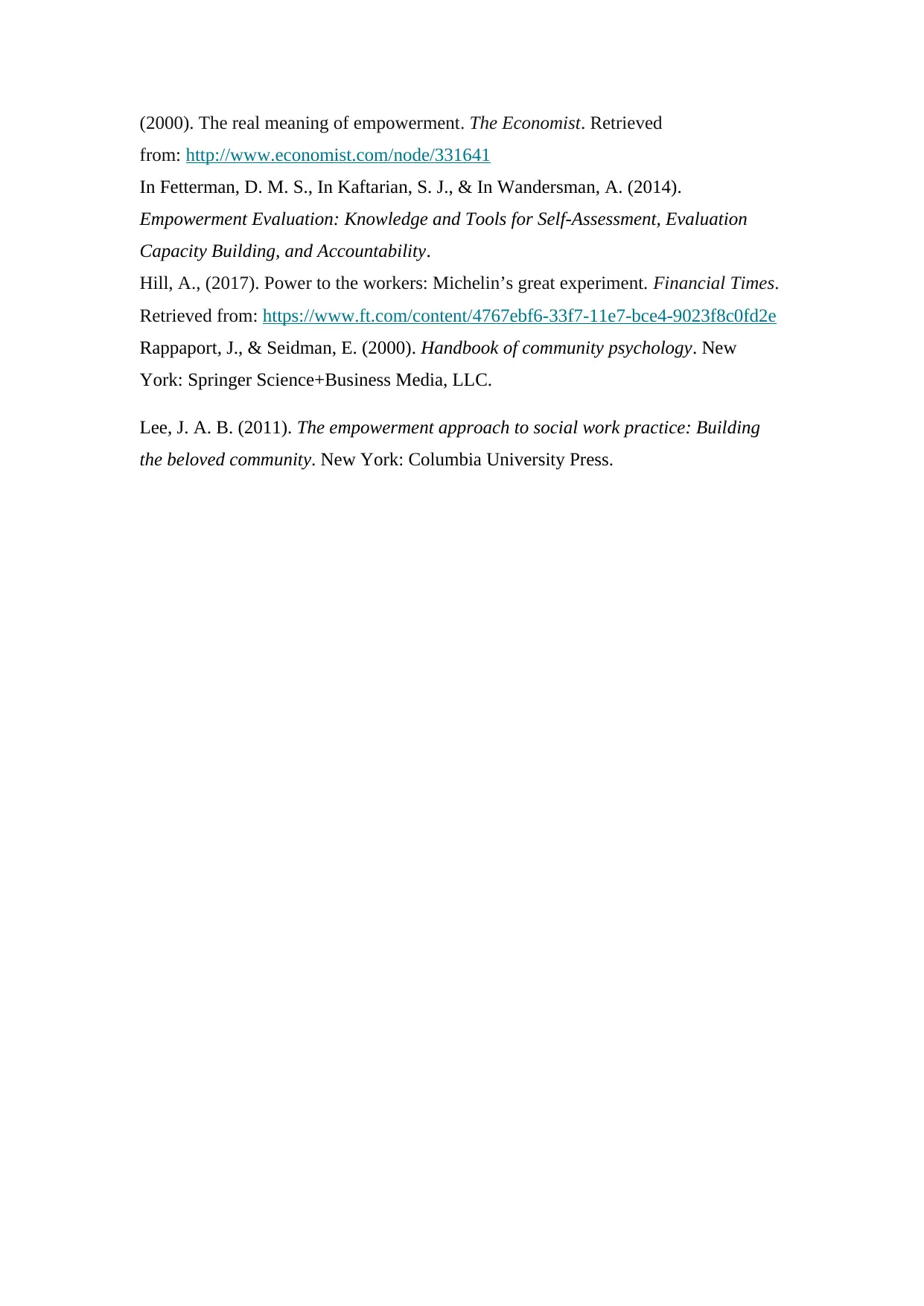
(2000). The real meaning of empowerment. The Economist. Retrieved
from: http://www.economist.com/node/331641
In Fetterman, D. M. S., In Kaftarian, S. J., & In Wandersman, A. (2014).
Empowerment Evaluation: Knowledge and Tools for Self-Assessment, Evaluation
Capacity Building, and Accountability.
Hill, A., (2017). Power to the workers: Michelin’s great experiment. Financial Times.
Retrieved from: https://www.ft.com/content/4767ebf6-33f7-11e7-bce4-9023f8c0fd2e
Rappaport, J., & Seidman, E. (2000). Handbook of community psychology. New
York: Springer Science+Business Media, LLC.
Lee, J. A. B. (2011). The empowerment approach to social work practice: Building
the beloved community. New York: Columbia University Press.
from: http://www.economist.com/node/331641
In Fetterman, D. M. S., In Kaftarian, S. J., & In Wandersman, A. (2014).
Empowerment Evaluation: Knowledge and Tools for Self-Assessment, Evaluation
Capacity Building, and Accountability.
Hill, A., (2017). Power to the workers: Michelin’s great experiment. Financial Times.
Retrieved from: https://www.ft.com/content/4767ebf6-33f7-11e7-bce4-9023f8c0fd2e
Rappaport, J., & Seidman, E. (2000). Handbook of community psychology. New
York: Springer Science+Business Media, LLC.
Lee, J. A. B. (2011). The empowerment approach to social work practice: Building
the beloved community. New York: Columbia University Press.
1 out of 7
Related Documents
Your All-in-One AI-Powered Toolkit for Academic Success.
+13062052269
info@desklib.com
Available 24*7 on WhatsApp / Email
![[object Object]](/_next/static/media/star-bottom.7253800d.svg)
Unlock your academic potential
Copyright © 2020–2025 A2Z Services. All Rights Reserved. Developed and managed by ZUCOL.




